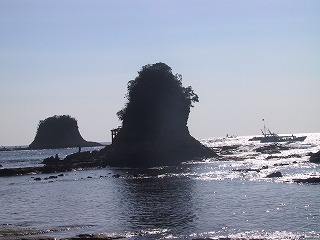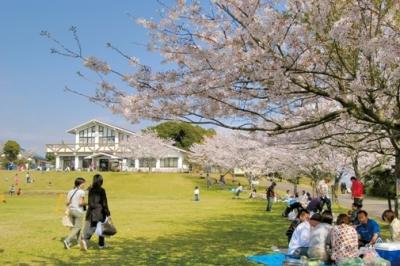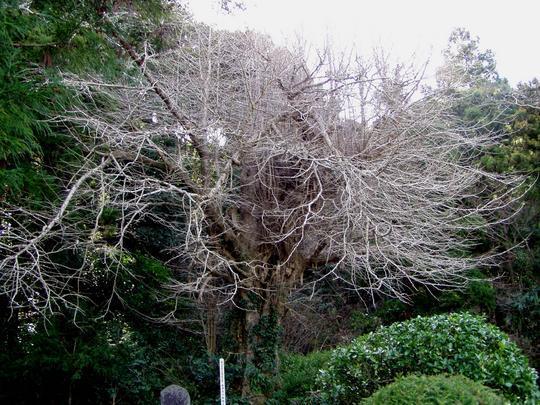本文
Notable Locations and Landmarks
Natural Landmarks / Locations
Matsushima Island
A Natural Scenic Landmark
Kamogawa Matsushima consists of seven differently sized islands, is said to be the best sight of the Sotobo (Outer Boso Peninsula) Region. The image of Kamogawa Matsushima against a backdrop of the sun rising from the ocean's horizon is a particularly breathtaking view. During the summer, visitors can also enjoy swimming, fishing, and playing on the shore.
Obenten and Kobenten Islands
A Landmark of Natural Beauty


On the day Holy Priest Nichiren was born, it was said that three miracles occurred: a spring of water gushed from the corner of the garden, lotus flowers blossomed on the beach, countless sea bream fish gathered up near the surface of the sea. As if to attest to this legend, the two small islands float in the middle of the bay, most commonly known as “Obenten” and “Kobenten” respectively, have also been called the "Gathering of Lotus Flowers." Furthermore, the beautiful sand on the beach that seems to reflect different colors is also known as "Five Color Sand."

Niemonjima Island
An Island of Legend

Designated as a place of scenic beauty by Chiba Prefecture, the 30,000square meters island is said to be a reward given to Niemon Hirano for saving the great Shogun Minamoto-no-Yoritomo after he was defeated in the Battle of Ishibashiyama.
Even now, traditional style ferry boats sail from the shore across to the island. Flowers bloom on the island all year round. Niemonjima is also home to a rare plant called kinginhalinasu (a kind of eggplant).
Additional points of interest are the cave where Yoritomo hid from pursuers, and a Haiku monument inscribed with poems about the island’s beauty throughout the seasons.
Hours of operation: 8:30am-5:00pm, open 7 days a week
Transportation: 12 minutes on foot from JR Futomi Station. (Also accessible via bus from JR Awa-Kamogawa Station.)
Phone: 04-7092-3456
Oyama Senmaida Terraced Rice Fields

The cultivation of the hillsides of mountainous regions was a common sight throughout Japan, including Kamogawa, until the late 1970s. However, due to the increase in the use of machinery and an aging population of farmers, this landscape is rapidly disappearing. Within Kamogawa, the terraced rice paddies of Oyama Senmaida continue to be carefully maintained and cultivated to this day. The puzzle piece-like fields of the Oyama Senmaida fitting together to create curvy steps up the mountainside, are the very image of Japanese farming villages. Oyama Senmaida was recognized in 2002 as a “cultural landscape,” created mutually by people and nature, when it was designated by Chiba Prefecture as a Prefectural Landmark. Currently, the Oyama Senmaida fields are being maintained by the “owner system,” which works to contribute toward local revitalization by helping to preserve this beautiful landscape and provide a place for urban dwellers to try their hand at farming.

For inquiries, please contact the Kamogawa Folk Museum (Phone: 04-7093-3800).
Terraced Rice Paddy Owner System
In recent years, the issue of Japan’s aging society has come to affect the management of rice fields as well. Plots of unused rice fields increase as farmers age and their children move away to big cities, leaving no one to tend to the family farms and rice paddies. To counter this problem, the Oyama Senmaida has introduced a land adopting system called the “owner system.” With this system, anyone can adopt a small plot of land and experience rice planting first-hand. This program is designed for anyone, such as metropolitan area residents, who are looking for a break from the hustle and bustle of big cities. The “owner system” allows owners to plant, cultivate, and harvest their very own rice.
Each step of rice production is taught by local farmers. Even if an owner cannot participate in one of the above activities, the paddies are under the constant supervision of Oyama Senmaida Preservation Society. All rice harvested at the end of the season will be given to the field’s owner (usually produces about 40kilogram of rice).
Registration Period: Every year from October to January
Owner Membership Fee: 30,000 yen per 100 sq. meters
Sample Schedule of Owner Events:
- (early March) Orientation
- (early May) Plant seeds
- (early June, late July, and mid-August) Mow grass
- (early September) Harvest rice crops
- (late September) Harvest festival
Uomizuka Lookout Point

Standing 110 meters above sea level, you can enjoy a beautiful panoramic view of downtown Kamogawa, the Kiyosumi Mountain chain, and the Pacific Ocean during the daytime from the Uomizuka Lookout Point. At night, watch the twinkling lights of the Kamogawa in while taking in the vast starry night sky.
Additionally, a work by the famous sculptor and Kamogawa native, Kou Hasegawa, the statue of the goddess Gyofu (“dawn breeze”) boldly looks out to the sea from Uomizuka.
Transportation: Take bus from Awa-Kamogawa Station and get off at the bus stop for “Matsushima.”Uomizuka Lookout Point is a 10 minute walk from the bus stop.
Issemba Park

Issemba Park is located directly behind Uomizuka Lookout Point.
The cherry blossoms here bloom beautifully in the spring. This park is one of Kamogawa’s hot spots for hanami, or cherry blossom viewing, in Kamogawa.
Tennis courts, the gymnasium, and leisure facilities such as the Super Slider are available for use by Kamogawa residents. (Some facilities may require a fee. Please call in advance to confirm.) Come and enjoy your free time with your family and friends.
For details about the facilities at the park, check the Sports Facilties page.
Yomogi and Fudo Waterfalls
Popular Fall Foliage Spot
Pass through Kiyosumi, drive deep into mountains, and you will find yourself in the midst of a lush forest of bamboo and cedar trees. Yomogi, which literally means 40,000 trees, is considered by the locals as a secluded haven.
At the center of forest are the Fudo Waterfalls, majestic at 10 meters in height and 8 meters in width. When there is an abundance of water, the waterfall splits into two: "male waterfall" on the right and "female waterfall" on the left. Whether surrounded by the new greens of early summer or the deep reds of autumn, Yomogi and the Fudo Waterfalls are picturesque and beautiful all year round.
Forest Blue Frog
Forest Blue Frogs are the only frogs native to Japan and can be found in the mountainous areas of Honshu, Shikoku and Kyushu. Between May and July, eggs are laid on tree barks. There is a 10 day primary hatching cycle after which time the eggs naturally drop into the body of water under the tree and continue hatching. When frogs mature, they return to the tree. This process can be observed inside the grounds of Seichoji Temple every year.

Sister Ginkgo
Standing at 18 meters tall, this ginkgo tree takes on an interesting shape as it looks like two trunks wrapped around each other, thus the name, “Sister Ginkgo.” The unique shape is a rare sight in southern Chiba.

Notable Buildings and Landmarks
Izumi Community House
National Registered Cultural Asset

The Izumi District was the first district of Kamogawa to implement farming land management (division and exchange of land, editing division of plots, and maintenance of roads and plumage). Because the residents of this area needed a facility where they could all gather together to discuss issues, the Izumi Community House was built in 1921.
Location: 1612 Izumi, Kamogawa
Transportation: 40 minute walk from Awa-Kamogawa Station, or 20 minute walk from the bus stop “Tojo Byoin-mae”
Phone: 04-7093-3800 (Kamogawa Folk Museum)
House of Mikio Mizuta
National Registered Cultural Asset

Mikio Mizuta was born in this house in 1905, which is located in Kamogawa’s Soro District. He served as the Minister of Finance during the postwar period and helped Japan grow economically to become what it is today. This house displays the characteristics of a traditional Boso style home.
The House of Mikio Mizuta is currently managed by Josai University, which he helped found, and is open to the public.
Hours: 9:00am-5:00pm daily (closed Tuesdays)
Address: 339-1 Nishi, Kamogawa
Transportation: 20 minute walk from the bus stop “Soro Shuten” along the Soro bus route from Futomi Station
Phone: 04-7093-3800 (Kamogawa Folk Museum)
Birthplace of Chikashi Koizumi

Poet Chikashi Koizumi was the firstborn of a farming family in Kamogawa and is a famous figure in the history of contemporary Japanese tanka poetry. Although his birthplace has been rebuilt, a number of relics from his lifetime remain throughout the city.
Landing Spot of the Russians

In 1739, during Japan’s period of seclusion, the Russians landed in Amatsu as part of an investigation team. This was the first recorded landing of Russians in Japan (excluding Hokkaido). Books written based on the accounts of the residents of the time tell of details of the historical event.





